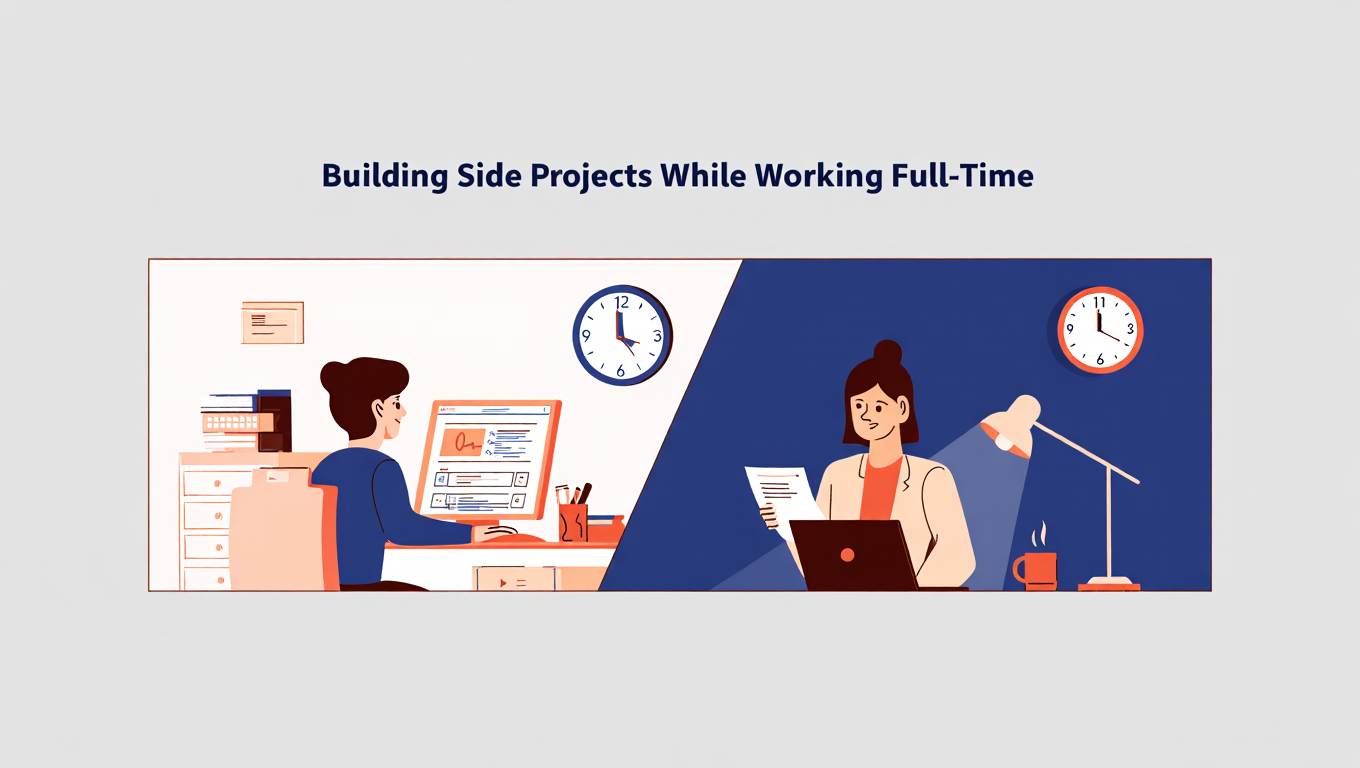Building Side Projects While Working Full-Time
I've built multiple side projects while working as a full-time developer. Here's the reality of finding time, avoiding burnout, and what 2-4 hours a day can actually accomplish.

I've shipped side projects while working a full-time developer job.
Not because I have more hours in the day. Not because I'm some productivity superhuman. Not because I don't have a life outside of code.
Because if you actually want to build something, you find the time.
Here's what that looks like in practice.
Why Most Side Projects Never Ship
The problem isn't time.
The problem is thinking you need massive blocks of uninterrupted time to make meaningful progress. You're waiting for that perfect weekend. That vacation week. That moment when everything aligns.
It never comes.
I used to think the same way. "I'll start that project when work slows down." Work never slows down. "I'll build it when I have a full Saturday free." That Saturday gets filled with life, errands, friends, sleep.
The developers who ship side projects aren't the ones with more free time.
They're the ones who stopped waiting for it.
What 2-4 Hours a Day Actually Gets You
Consistent effort beats sporadic marathons.
I've built and launched functional products with just 2-4 hours a day after my 9-to-5. That's not a lot. But compounded over weeks and months, it adds up to something real.
Here's the math.. 2 hours a day is 10 hours a week. That's 40 hours a month. A full work week's worth of focused development time.
In my experience..
- Week 1-2.. Core functionality. The thing that makes your project unique. Not the auth system, not the fancy UI. The core feature.
- Week 3-4.. Make it usable. Basic UI, essential flows, minimum viable product.
- Week 5-6.. Polish and deploy. Fix the obvious bugs, make it presentable, ship it.
I shipped a Django-based automation tool in 6 weeks working evenings after my full-time job. It wasn't perfect. It had rough edges. But it worked, and people used it.
That's the point.
How I Actually Find Time (Without Burning Out)
Start Immediately After Work
The transition from day job to side project is the hardest part.
I don't take a long break. I don't scroll Twitter for 30 minutes. I don't "decompress" by watching YouTube. Those 30 minutes turn into 2 hours, and suddenly it's 9 PM and I'm too tired to code.
Instead.. I close Slack, open my side project repo, and start coding within 15 minutes of ending my work day.
The momentum from already being in "work mode" carries over.
Work in Fixed Time Blocks
I use 90-minute blocks.
Not 4 hours. Not "until it's done." Exactly 90 minutes. Then I stop.
This does two things..
- Prevents burnout. You're not grinding until midnight every night.
- Forces prioritization. You can't afford to bikeshed color choices when you only have 90 minutes.
I use a second block if I have energy, but I never count on it. One block is the baseline.
Avoid Context Switching
Don't use your day job's tech stack for your side project.
I know this sounds counterintuitive. Everyone says "use what you know" to ship faster. But if I spent 8 hours writing React at work, the last thing I want to do is write more React at night.
I use side projects to explore different tools. When I was deep in Django at my day job, I built side projects with Go and htmx. It kept things fresh, and I learned new skills that actually made me better at my job.
The mental separation matters more than raw speed.
Weekend Strategy
Weekends are for big pushes, not regular work.
I don't code every Saturday and Sunday. That's a fast track to burnout. Instead, I reserve weekends for specific milestones.. deploying to production, integrating a complex feature, refactoring something that's been bugging me.
Most weekends, I don't touch my side project at all.
And that's fine.
The Reality of Balancing Day Job and Side Projects
Let me be honest.. some weeks you won't code at all.
Work gets busy. Life happens. You're tired. You need to rest.
I've had two-week stretches where I didn't open my side project once. And I used to beat myself up about it. "I'm not disciplined enough. I'm never going to finish this."
Then I realized.. side projects aren't a sprint. They're a long game.
The key is coming back. Not abandoning the project entirely. Just coming back when you have the energy.
What Actually Causes Burnout
It's not the coding.
It's the guilt.
Guilt when you're not working on your side project. Guilt when you take a break. Guilt when you choose to go out with friends instead of fixing that bug.
I stopped feeling guilty when I reframed it.. This is a side project. It's supposed to be fun.
If it stops being fun, if it feels like a second job, you're doing it wrong. Take a break. Work on something else. Come back later.
Setting Realistic Expectations
Most side projects take 3-6 months to ship.
Not 3 weeks. Not "one weekend." Months.
And that's if you're working consistently. If you're only putting in 2 hours a day, the timeline stretches. That's reality.
I used to underestimate every project by 10x. "I'll finish this in 2 weeks." Six weeks later, I'm still building features. Now I plan for 3 months minimum, and I'm rarely disappointed.
What Side Projects Have Actually Done for Me
Better Job Opportunities
Every job interview veers towards my side projects.
Hiring managers care more about what you've built on your own than what you've done at work. Side projects prove you can ship. They show initiative. They demonstrate you actually enjoy coding, not just collecting a paycheck.
My side projects have led to freelance work, consulting gigs, and multiple job offers I didn't even apply for.
Real Learning
You learn more building your own thing than following tutorials.
When it's your project, you hit problems that no tutorial covers. You make decisions that matter. You deal with the consequences.
I learned more about deployment, caching, and performance optimization from shipping one side project than I did from 2 years of "safe" corporate development.
Financial Upside (Maybe)
Some side projects make money. Most don't.
I've had projects that generated $200/month passively for years. I've had projects that got 10,000 users and made $0. I've had projects that nobody used at all.
Don't build a side project expecting it to replace your income. Build it to learn, to experiment, to scratch your own itch. If it makes money, great. If not, you still gained something.
What You Should Do Next
Here's what actually matters..
- Start with 2 hours a day, not 8. Consistency beats intensity.
- Pick a project you'd use yourself. External motivation fades. Scratching your own itch doesn't.
- Ship something imperfect in 6 weeks rather than something perfect never.
Start here..
Block 90 minutes tonight. Not tomorrow. Tonight. Open your editor. Write one function, one component, one feature. Commit it. Push it.
Do that again tomorrow.
That's how side projects get built.
